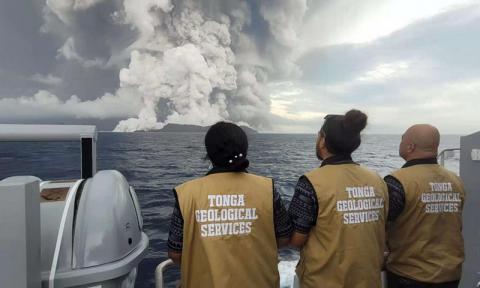KATC Meteorologist Jobie Lagrange visited Hamilton Hall to give a guest lecture about hurricanes for students in Int
School of Geosciences Scientist involved in study of submarine violent explosions
Wed, 02/02/2022 - 7:47amOn January 14, 2022, a mega volcanic eruption in Tonga (southern Pacific Ocean) sent a powerful shock wave across the globe.
With tsunami waves up to 15 m and an energy estimated equivalent to 4 to 18 megatons of TNT, this catastrophic explosion reminds us that our planet is very much alive.

Members of the Tonga Geological Survey observe the Hunga Tonga-Hunga Ha'apai volcano eruption in Tonga. (Photo Tonga Geological Services of the Government of Tonga/Xinhua)
The Hunga Tonga-Hunga Ha’apai Eruption, a Multi-Hazard Event
One of our UL scientists, from the School of Geosciences, Dr. Eric Ferré, is involved in a study of a similarly violent, albeit smaller, submarine explosion in the same region.
The Havre submarine volcano, located in the Kermadec Islands, lies between ~1500 and 600 m below the sea surface.
The 2012 Havre eruption of this volcano is the largest recorded silicic submarine eruption in history (~1.5 km3) and was unobserved until a very large field of floating volcanic rock (pumice) was found by boats sailing in the area.
A more recent (2019) example of such gigantic floating field of pumice is shown here:
Dr. Ferré research on the magnetic properties of the pumice, in collaboration with one of his former students, Joe Knafelc, now at Queensland University of Technology (QUT), in Brisbane Australia and Dr. Scott Bryan and Dr. Michael Jones, also at QUT, will be published soon in Communications in Earth and Environment, a high impact factor journal of the Nature Group.
The magnetic measurements in this study, performed at the University of Louisiana at Lafayette, helped constrain the duration of the 2012 Havre eruption through the identification of magnetite nanolites, which are thought to have triggered the eruption.
Residents of Louisiana can relax ... there are no known seamounts or submarine volcanoes in the Gulf of Mexico!
